
“Female labourers would be covered in ash,” she says. “They had to do seeding, ploughing. They had to work for rations.” She pauses. “[There’s] the idea of ghosts, remnants of histories and stories in these spaces.”
Ships and plantations, she says, were sites of rape and abuse. Instances of violence play out across kūlī / karambu, scenes that imagine the lives of Indarami’s ancestors at a scale that’s both intimate and epic. But Simpson is equally interested in how women in her family may have resisted.
“I’d read about women who hit men with a master’s shoe, a woman who peed on an overseer,” she says, flashing a bemused grin.
Indarami and her daughter often share ideas.
“[My mother] says, ‘why don’t you work on one painting at a time? Or ‘maybe it needs more yellow’,” Simpson laughs. “Her metaphor is ‘you’re the star and we’re the back-up dancers’.”
Indarami is astonished by her daughter’s work.
“It’s ‘let us honour you for what you have been through’,” says Indarami, who moved to Australia at the end of Apartheid. “Sancintya is a very independent person. I’ve seen her develop as an artist from within. Her work is from her heart and her being.”
Phaptawan Suwannakudt is the daughter of Paiboon Suwannakudt, the late artist and poet who is considered Thailand’s master of temple painting. She owes her name to the Thai for ‘image of the sun’, after a poem her father wrote on the day of her birth about a red sun above Bangkok’s Chao Phraya River.
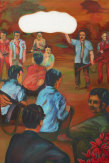
Phaptawan Suwannakudt ‘RE al-re-g(l)ory’ 2021.
Paiboon, she says, was trained by Corrado Feroci, the Italian sculptor who was invited by the then King to establish Thailand’s first art school in 1923. The Thai-Australian artist started watching her father at work when she was a girl and took over his workshop at 22, in 1982, the year he died.
In Suwannakudt’s studio, trolleys and tables heave with jars of paint: lime-green, orange, indigo. A far wall supports a row of paintings, evoking the lurid colours of propaganda. The space, part of Marrickville’s Addison Road Community Centre, was once used to conscript Vietnam War soldiers.
“When I was in my teens, I started to see paintings that [portrayed] communism as evil,” says Suwannakudt, articulate and softly spoken, in a black shirt and glasses.
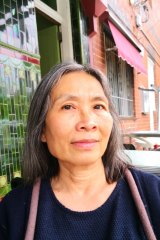
Artist Phaptawan SuwannakudtCredit:John Clark/AGNSW
At her father’s workshop, she worked with painters from the country’s north-east, a region then feared to be communist. In 1977, they were arrested for breaking government curfew. In the last few years, she’s seen parallels in the Thai state’s crackdown on democratic freedoms, under Prime Minister Prayut Chan-o-cha who came to power during a 2014 military coup.
The artist is heartened by Thailand’s growing pro-democracy movement. She shows me a printout of Thai students, holding A4 paper over their faces, an attempt to shield their identities.
RE al-Re-g(l)ory (2020), her installation for The National, showing at AGNSW, features a sequence of paintings recalling Thai Cold War posters. They’re interspersed with white boards, symbols of generational protest.
Her daughter, Cantra-Chaaysaeng and son, Yenlamtarn, both help her with studio work. She tells me she’s proud that Cantra-Chaaysaeng attended last year’s Black Lives Matter protests.

Phaptawan Suwannakudt ‘RE al-re-g(l)ory’ 2021.
“They feel they have to be part of it,” she smiles. “The children are saying enough is enough.”
Western art history so often mythologises the artist as a singular hero, erasing the ways in which creative labour can be shaped by lineage, or arise out of our relationships with other people. The National 2021 coincides with a year that’s shown us the value of interdependence, the power of acting collectively.
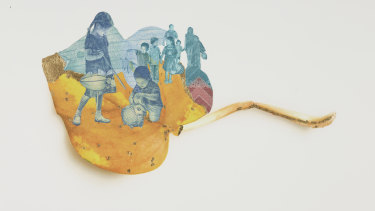
Abdullah M.I. Syed, ‘Hong Kong Dollar HKD 20 (verso)’ from the series ‘Currency of Love’ 2021 (detail).Credit:Felicity Jenkins/AGNSW
Carriageworks will present A Day in the Life, a work by Karrabing Film Collective. The group comprises 30 Indigenous artists and filmmakers, spanning different generations. At AGNSW, you can see Last Observances. It’s a video installation in which the Pakistan-born artist Abdullah M. I. Syed, recreates the domestic rituals of his mother, who passed away in 2019.
Domesticity has long informed Mitch Cairns’ visual vernacular. He’s an artist for whom motifs from everyday life – an apple core, say, or a bathroom mirror – become the stuff of witty and intelligent paintings whose rewards grow the longer you look.
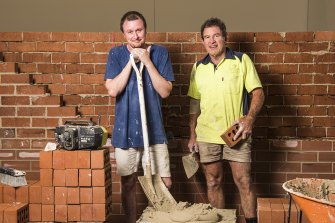
Artist Mitch Cairns building a red brick wall with his bricklayer father, David, at Carriageworks. Credit:Steven Siewert
Cairns grew up in Casula and later moved with his family to Wollongong. When he was commuting to Sydney’s National Art School, he supported himself by working as a labourer for his father, David, a bricklayer.
“That was my first exposure to physical work,” he says. “It was early thinking around labour, structure – just very basic sort of things.”
For The National, Cairns, who’s warm and affable but moves with the serious painter’s restless intensity, is working on three paintings and a series of text works. When I visit, Self-portrait as an autumnal low (2021), commands one side of Cairns’ high-ceilinged Alexandria studio, balancing on a pair of milk crates. Yellow leaves hover mid-air, a composition that both possesses a sense of musicality and is perfectly still.

Artist Mitch Cairns building a red brick wall.Credit:Steven Siewert.
Cairn says his father has visited every one of his exhibitions. As part of his presentation at Carriageworks for The National, the pair have built a brick wall together.
“A brick wall is a very declarative statement, but [there are] softer and quieter moments within that gesture that are going to be uncovered in the making,” he says. “There’s a permanency in fixing an image but it is far less permanent than what [my father] does.”
Cairns won the 2017 Archibald for a lovingly rendered portrait of his wife, the artist Agatha Gothe-Snape, with whom he shares a young son. The wall, he says, is part of his interest in the slippages between art and life that have followed him from the start of his career.
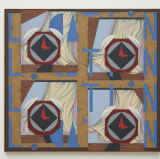
‘Location painting’ by Mitch Cairns.
“[I’m] never willing to untether myself from the not-knowing of what art is,” he smiles.
Family, of course, isn’t limited to spouses, or children or blood kin. For Erin Vink, a Ngiyampaa woman and AGNSW’s assistant curator of Aboriginal and Torres Strait Islander art, the kinship we share with other people extends to the land as well.
“Country is a sentient thing, so we have to care for it like a family member,” says Vink, who co-curated the AGNSW strand of The National alongside Matt Cox. “We are all facing these major threats to humanity – climate change, biological disasters. The exhibition is about being resilient and having hope.”
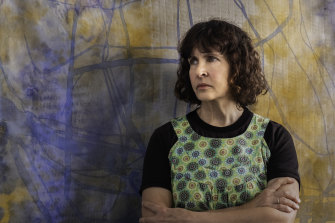
Judy Watson is responding to how mining has degraded the Murray-Darling basin and our water supplies.Credit:Rachel See
She’s excited about new paintings by Betty Muffler and Maringka Burton, along with Judy Watson.
Watson remembers visiting her mother’s Waanyi Country near Queensland’s Mount Isa in the 1970s.
“If there was a storm, you could go out to the creek and have this amazing clean water rushing through and all the waterholes would be filled,” she says, wistfully. “My grandmother would go in [wearing] a dress. You would see us all bobbing around.”
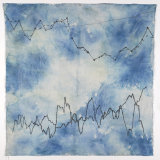
Judy Watson’s work ‘water restrictions and conditions in the Murray-Darling basin” from the series ‘clouds and undercurrents’, 2021Credit:Carl Warner
Watson tells me about how mining across the Murray-Darling Basin has degraded Sydney’s water bodies. Her work for The National, a series called clouds and undercurrents, explores ideas of air and water quality. She makes the ethereal paintings, dyed with indigo, graphite and mangrove mud, using shibori, a traditional Japanese technique.
“My cousin Dot Watson and I have had the best time together in her backyard, working with shibori – same with Mum and her family,” she says. “I love being in the studio making work by myself, but I love sharing it in the company of others.”
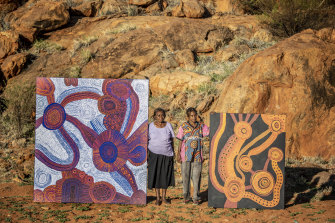
Betty Kuntiwa Pumani and her daughter Marina with some of their work in early 2020.Credit:Meg Hansen Photography
Like Watson, Betty Kuntiwa Pumani’s art is shaped by a profound connection to her mother’s Antara Country. Pumani is the daughter of Milatjari Pumani, who was a senior Pitjantjatjara artist from the Anangu Pitjantjatjara Yankunytjatjara (APY) Lands in South Australia.
For The National, Pumani spent six months making a 10-metre long painting, Antara (2020), a work that explores the witchetty grub songline and conjures the power of Antara Country, surrounded by waterholes and mountains, in dazzling whites, blues and deep reds.
Pumani, who will show at the MCA and often collaborates with her daughter Marina says that painting is about interpreting her mother’s knowledge.
Loading
“What I have shared is what I paint – the true story of Antara Maku Dreaming,” Pumani says via a written translation. “It is the main story I was taught by my mother, the main story I need to look after.”
Pumani says that her grandchildren and daughter would watch her process. Painting, she says, is a cultural inheritance shared with the world and exchanged between different generations.
Simpson, too, believes that her art-making comes with a responsibility to those that have gone before her.
“I have a real sense of duty,” she smiles. “I’m in a position to have a voice and I should use it to tell the stories of my family who weren’t able to speak.”
The National 2021 shows at AGNSW from March 26 to September 5, at Carriageworks from March 26 to June 20 and the MCA from March 26 to August 22, 2021.
Neha Kale is a columnist.






 Add Category
Add Category